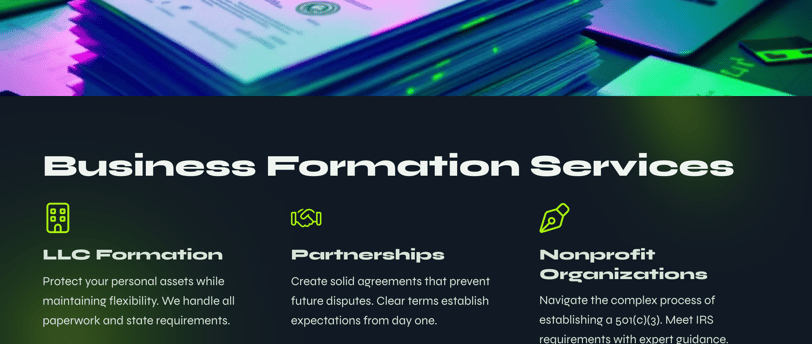Understanding Business Formation in the U.S
Learn the pros & cons of LLCs, S-Corps, C-Corps, nonprofits & more. Discover the best U.S. business structure for tax, liability & growth.
3/26/20253 min read


Understanding Business Formation in the U.S.: LLCs, Corporations, and More
Starting or restructuring a business? One of the most important decisions you'll make is choosing the right legal entity. It’s not just paperwork—it affects your taxes, liability, growth potential, and even your personal protection. Let’s break it down so you can move forward with clarity.
Sole Proprietorship – The Simplest Start
This is the default structure for solo entrepreneurs. There’s no formal registration (except for local licenses), but that also means no liability protection—your personal and business assets are one and the same.
Example: A freelance designer or online coach starting out without registering a company is often a sole proprietor by default.
Best For:
Simple, low-risk businesses
Solo operators testing the waters
Partnership – Business With a Buddy
If two or more people go into business together without forming an entity, they’ve created a general partnership. Profits “pass through” to the partners’ personal tax returns, but again—no liability shield unless you form a Limited Partnership (LP) or Limited Liability Partnership (LLP).
Example: A law firm might operate as an LLP, offering some liability protection to its partners.
Best For:
Professionals working together
Family-owned businesses
LLC (Limited Liability Company) – Flexibility Meets Protection
The LLC is one of the most popular structures in the U.S., and for good reason. It provides personal liability protection (your personal assets are safe) while keeping the tax structure flexible. Income “passes through” to the owners (called “members”), avoiding corporate taxes unless you elect otherwise.
Famous Example: Nike, Inc. originally started as a partnership but later transitioned into a corporation. Many smaller subsidiaries or startup brands today operate as LLCs during their early growth phase.
Best For:
Small-to-medium businesses
Real estate investors
Startups and family businesses
C-Corporation – Built for Scale
A C-Corporation is a separate legal and tax entity. That means the company itself pays taxes on profits, and shareholders pay taxes again on dividends—this is known as double taxation. However, C-corps are ideal for raising capital, issuing stock, and going public.
Famous Example: Apple, Inc. and Amazon are both C-Corps. They issue shares, attract investors, and operate globally under this structure.
Best For:
Companies planning to raise VC funding or go public
Businesses with multiple classes of stock
High-growth startups
S-Corporation – Small Business Favorite (With Rules)
An S-Corporation combines the liability protection of a C-corp with the tax benefits of an LLC. Profits pass through to shareholders (like in an LLC), avoiding double taxation. But there are strict limits:
Only U.S. citizens/residents can be shareholders
Max of 100 shareholders
Only one class of stock allowed
Famous Example: While large enterprises rarely qualify, many small-to-medium businesses—including professional service firms—thrive as S-corps for the tax advantages and credibility.
Best For:
Profitable businesses with stable income
Owners who want to reduce self-employment taxes
Nonprofit Corporation – Mission Over Money
A nonprofit corporation exists to serve a public or charitable purpose, not to make a profit. You can apply for 501(c)(3) status to be exempt from federal income taxes, but must meet strict guidelines for how funds are used.
Famous Example: The American Red Cross is a nonprofit that operates under 501(c)(3) status.
Best For:
Charitable, educational, religious, and scientific organizations
Those seeking donations and grant funding
B-Corporation – The Hybrid of Profit & Purpose
A Benefit Corporation (B-Corp) is a for-profit company with a legally defined mission to create a positive impact on society and the environment. While not a tax-exempt entity like a nonprofit, B-Corps must report on social impact.
Famous Example: Patagonia and Ben & Jerry’s are certified B-Corps, known for their environmental and social responsibility.
Best For:
Purpose-driven companies
Social enterprises
Which Structure is Right for You?
Ask yourself:
Do you need to raise capital or issue stock?
Are you planning to grow aggressively or keep it local?
Do you want the flexibility of an LLC or the structure of a corporation?
Are you building a business or a legacy?
Let’s Talk About Your Business Goals
Choosing the right structure is not a one-size-fits-all decision. It’s about balancing liability, taxes, operations, and growth strategy. Whether you're launching your first LLC, restructuring your corporation, or exploring nonprofit or multi-entity setups—we can guide you through it.
📞 Contact us today at accuratebooksLS@gmail.com to schedule your Business Formation Strategy Session.
We’ll help you make the smartest decision for your business—now and in the long term.
LAW SIMPLIFIED
Business Law Education, Estate Planning Guidance, Nonprofit Legal Formation, Cryptocurrency Tax Planning, Foreign LLC Taxation, Trusts and Wills
Trust & WILL
More
Taxes & Estate Planning
501(c)(3) Step-by-Step
© 2024. All rights reserved.
